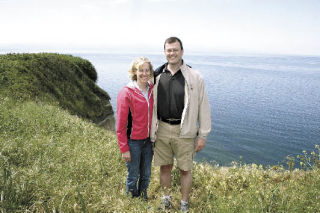Wings spread wide, a large raptor glides silently past the rim of the bluff.
“That’s an immature bald eagle,” said a grinning Bruce Russell.
Red-winged blackbirds flit from bush to bush. Looking out from this commanding spot northwest of Coupeville, there’s Canada, the San Juans, the blue Olympics. And the occasional pod of orcas.
“We’d been looking for a place on the water for some time,” said Russell of Freeland. “The day we found this lot the sunset was just magnificent. That pretty much did it for Melissa and me.”
Tom and Vicky Eisenberg felt the same in 1974 when they found their dream place on Camano Island’s wildlife-rich Port Susan Bay.
An avid outdoorsman, Tom Eisenberg is curious about every creature that walks, flies, crawls or swims. He relished the wild birds, fish and shellfish, and the nearby salmon stream, Kristoferson Creek.
Like many others drawn to the shores of Whidbey and Camano islands, it would be easy for both couples to say it can’t get much better than this. But they both know the truth lies deeper. It used to be better.
“We have a responsibility to take care of this,” Melissa Russell said.
“Bruce and I are learning. We moved to Whidbey from Pierce County six years ago. This is an island and everything we do affects our drinking water and the marine waters around us,” she said. “We have been living in the woods of South Whidbey. Now that we are moving to the shore it’s an entirely new climate and geology. We want to do things right — for the land, the beach, the bluff and everything that lives here.”
For the Eisenbergs, love of the shore and nature has led to a variety of community boards and roles, but none that Tom Eisenberg loves more than Friends of Camano Island Parks, for whom he leads many tours of Camano Island’s special places.
“It just comes naturally,” he said. “If you like to talk about your surroundings and your environment, it’s hard to shut me up.”
Vicky Eisenberg agreed, quick to point out that it’s all toward a purpose.
“We want to protect this for our grandchildren and the generations to come. If we don’t do it, nobody will.”
That mixture of passion and responsibility is what connects the Russells and the Eisenbergs, two couples on two islands who have never met. In 2003 the Eisenbergs became the first couple in Island County to join Shore Stewards, www.shorestewards.org/island, a new stewardship education program for shoreline owners.
Last month the Russells became the 500th household to sign up. Melissa Russell has been doing her homework. Since moving to Whidbey she completed training from Washington State University Extension as both a Waste Wise Volunteer and a Master Gardener, two programs that teach how to use the island’s resources wisely.
She and her husband are looking forward to learning more about shoreline living at the annual, one-day Sound Waters University, held every February in Coupeville, and from WSU Beach Watchers.
Scott Chase, who coordinates Shore Stewards, said Puget Sound’s salmon, birds and orcas are struggling in part because generations of homeowners made decisions about their beaches, bluffs, lawns and gardens with little understanding of the impact.
“We lost precious habitat, damaged the food chain and polluted the waters,” he said. “Now, property-by-property, we need to do things differently.”
“The way to turn things around is not more laws but better everyday decisions by hundreds of thousands of people. That’s the whole purpose of Shore Stewards — to help people find habitat-friendly solutions for their properties. We give people resources and a chance to learn.”
For the Russells, and other shoreline residents like them, the program will gently guide them toward drought-resistant native landscaping, better care of their bluffs and septic systems, rainwater collection for their gardens, fewer chemicals, and greater reliance on composting and recycling. It will also make them better observers of nature.
The Eisenbergs know from experience that property owners are often the first to notice troubling changes, and can be the catalyst to solutions.
Years ago they became curious about a tough variety of grass that was growing in their bay, choking the fish and crab out of it.
“My brother kept looking at it and asking, ‘What the heck is that grass out there? Did you ever see it before?’ I said, ‘No, but I’m starting to see it everywhere,’” Tom Eisenberg said.
That was the beginning of a 20-year successful fight against invasive spartina, in which Eisenberg brought the plant to the county’s attention and organized neighboring property owners.
“We formed the Triangle Cove Task Force,” he said. “I went over to Driftwood Shores, the most heavily populated area, and spoke to their homeowners’ meeting.
“One old guy said there used to be sea-run cutthroat trout and crab. I asked how long ago that fell apart. He said, ‘About the time the grass showed up.’”
“That grass choked everything,” Vicky Eisenberg said. “That monoculture – it grows so thickly. Even in the mud there are no worms, no clams, no mollusks — nothing. But now, once again, we’ve got salmon going up the creek at the end of the bay.”
Property owners are getting smarter, Tom Eisenberg said. While it’s painful to watch more and more houses squeeze onto the remaining shoreline, he feels encouraged by the rising public awareness.
“I think the people of these islands, most of them, really want to do the right thing,” he said. “Programs like this — Shore Stewards — are educating people who live along the shore.”
Eisenberg said he is also greatly heartened by the volunteer spirit of the community.
“The number of people who come to these programs — geez, it amazes me. They are willing to support them, willing to do anything to help.”



